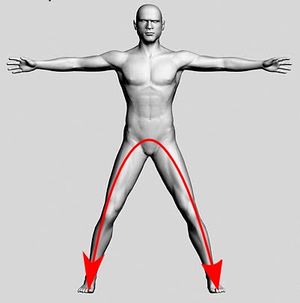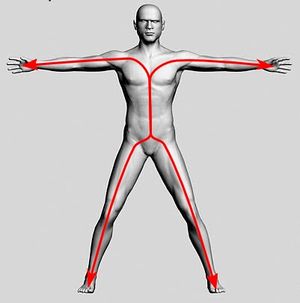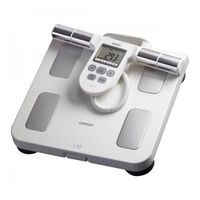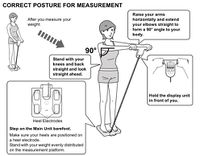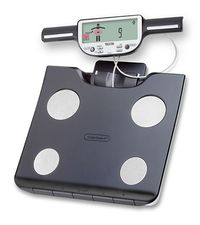Body Fat Scales
Body fat scales The right body fat scales can provide a cost-effective and convenient way of measuring body fat. The right body fat scales are ones which measure from the hands and feet, rather than the feet alone.
Contents
[hide]1 How they work
These Bioelectrical Impedance Analysis (BIA) scales use an imperceptible electrical signal to calculate the amount of water in the body. From this Total Body Water (TBW), it is possible to estimate body fat. You can see in the image below the path electricity takes with scales that measure via feet.
By comparison, you can see the path taken when measurements are from the hands and feet.
2 Recommended scales – Omron HBF-510
Having tried several body fat scales I would highly recommend the Omron HBF-510, which retails for about $60-$65 on Amazon.com. The scales measure from both the hands and feet providing reasonable accuracy for relatively low cost.
To use the scales you simply step on them holding the handset with your arms at 90°. After a few seconds these scales will display your weight, body fat and other metrics.
It's important to get the posture just right, as even small variations in arm position make a significant change to the reading.
3 Worth considering – Tanita BC-601
The Tanita BC-601 is a much more expensive set of body fat scales. In addition to measuring from the hands and feet, the scales use dual frequencies (see below) for greater accuracy. They also segment the body into five compartments, two arms, two legs, and the trunk, giving body fat readings for each compartment. The scales also write the measurements to a flash memory card for direct transfer to computer. Sadly, the scales are not sold directly the US and I imported mine from the UK which was expensive and remarkably time-consuming. With shipping I paid 185 GBP ($280) from http://www.scalesexpress.com, who messed up shipping the scales took nearly 2 months to be delivered. Given the price it's difficult to recommend the scales over the Omron scales. Tanita do sell other segmental scales in the US, such as the BC-558 Ironman, but these retail for over $350 and don't write to memory card.
4 Accuracy issues
Hydration can have a significant impact on the reading, so readings need to be taken at the same time of day with the same level of hydration. The 4 Hour Body recommend drinking 1.5 liters (3 pints) of water, waiting 30 minutes, urinating and then taking a measurement. I have found that with the whole body scales I can simply measure when I wake in the morning and get a consistent enough reading to not require this hydration procedure. The biggest problem for an athlete is that BIA is particularly inaccurate when fat free mass, including glycogen, changes[1][2]. I've noticed that the day after a long run, the scales claim a much larger loss of body fat than is reasonable. Studies have shown that obesity is underestimated with many body fat scales.
5 Details
Body fat scales work by comparing the electrical resistance of a direct current to alternating current. The direct current does not penetrate the cell walls whereas the alternating current does. This creates a difference that allows an estimate of extracellular water. Typically the alternating current is around 50 kHz, with dual frequency scales adding in 6.25 kHz for improved accuracy. Single frequency scales generally treat the body is a single cylinder with uniform resistance. Unfortunately because the arms and legs are thinner than the trunk they contributed disproportionate amount of resistance. Typically arms and legs are about 5 to 20% of body weight, but form about half of the overall resistance, while the trunk contains 50% of the body mass and contribute only 5 to 10% of the overall resistance. Dual frequency scales on the other hand segment the body up into five cylinders, two for the arms to for the legs and one for the trunk, giving much higher accuracy.
5.1 References
- Jump up ↑ Body composition changes assessed by bioelectrical impedance measurements http://www.ncbi.nlm.nih.gov/pubmed/2923071
- Jump up ↑ Changes in fat-free mass during weight loss measured by bioelectrical impedance and by densitometry http://www.ncbi.nlm.nih.gov/pubmed/2912008
